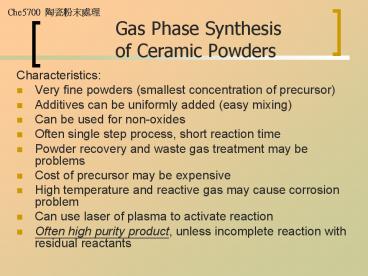Gas Phase Synthesis of Ceramic Powders - PowerPoint PPT Presentation
1 / 20
Title: Gas Phase Synthesis of Ceramic Powders
1
Gas Phase Synthesis of Ceramic Powders
Che5700 ??????
- Characteristics
- Very fine powders (smallest concentration of
precursor) - Additives can be uniformly added (easy mixing)
- Can be used for non-oxides
- Often single step process, short reaction time
- Powder recovery and waste gas treatment may be
problems - Cost of precursor may be expensive
- High temperature and reactive gas may cause
corrosion problem - Can use laser of plasma to activate reaction
- Often high purity product, unless incomplete
reaction with residual reactants
2
Classifications
Che5700 ??????
- Combustion (flame method) SiCl4 O2 ? SiO2 2
Cl2 to fabricate carbosil, aerosil etc already
commercialized, easy to get chain-like aggregates - Spray drying(decomposition by heating) can
obtain uniform powder, associated with
granulation, if operated improperly, may get hard
agglomerates - Laser method high purity, submicron products,
expensive, difficult to scale up - Conventional heating simple, broad application,
mostly for single component system - Plasma method high purity, fine powder used for
high energy barrier low pressure system, low
productivity, often amorphous, still require
calcination
3
Classification(2)
Che5700 ??????
- 6. Aerosol similar to spray drying various
sources since in solution, hence difficult for
non-oxides - CVD mostly for growing thin films
4
Chemical reaction ? nucleation, atomistic growth
(vapor deposition), particle-particle aggregation
5
(No Transcript)
6
fractals
7
Particle shape
Che5700 ??????
- Shape influenced by reaction temperature,
cooling rate, e.g. if T higher than melting point
of product ? spherical particles, fast cooling
(e.g. gt 106 oC/sec) ? often amorphous products. - If flame temperature slightly higher than melting
point, often become sticky particles ? easy to
form aggregates (fractals) - Cluster-cluster aggregation may happen high
temperature ? sintering is possible to change
particle shape. Particles obtained at low
temperature, tend to maintain its shape and
crystallinity.
8
Process Characteristics
Che5700 ??????
- Flame method principal method for silica and
titania - Plasma method (a) thermal e.g. DC arc, RF
induction to get plasma (b) low temperature use
glow discharge due to effect of electron and
ions in plasma ? create lots of active species
(may be radicals) ? fast reaction, for some
difficult synthesis reactions. Important
parameter E/P (electric field/pressure) cold
plasma E/P 103 V/cm-Pa thermal type E/P 10-4
V/cm-Pa - Laser method some laser function as heater, some
can activate molecules (special wavelength)
9
Flame Synthesis of Ceramic Powders
Che5700 ??????
- Different precursors can be used
- May need extra source of fuels
- Al2O3 Al(C3H7O)3 acetylacetonate
- SiO2 SiCl4
- TiO2 TiCl4
- C alkanes (C carbon black)
- Fe2O3, SnO2 metal chlorides
Adiabatic flame temperature exist for exothermic
reactions
10
Reaction Kinetics
Che5700 ??????
- For reaction like this a A b B ? d D the
rate equation is as follows - True kinetics depend on reaction conditions,
e.g. plasma condition must be different from
conventional heating ? different mechanism
11
Spray Drying or Roasting
Che5700 ??????
- Precursor solution was sprayed from orifice
(under high pressure), being heated to decompose
at the same time. Also used for granulation. - Drying and roasting the difference is in
temperature, higher for roasting, salt molecules
require higher temperature to decompose or react - E.g. Zn(NO3)2.6H2O (metal salt)? (105-130 oC) ?
Zn(NO3)2 6 H2O ? 550 oC ? ZnO (s) NOx (g)
12
Ultrasonic Gas Atomization
Che5700 ??????
- Gas nozzle that generates shock waves, in
association with ultrasound, to disintegrate melt
stream into droplets to get quickly solidified
metal particles. - This method relies on stable melt flow, fast
enough gas flow rate to disperse liquid into
small droplets - When liquid temperature is not high, often get
coarse particles (probably due to high viscosity,
difficult to disperse) high gas/melt ratio ?
fine particles - Ar, N2, He are often used
- Source Powder Metall. Internl, 18(5), 338-340
18(6), 422-425, 1986.
13
Various atomization process mostly for metal
powder production
14
(No Transcript)
15
(No Transcript)
16
(No Transcript)
17
Pyrolysis of Polymers
Che5700 ??????
- Similar to metal-organic decomposition.
- Polymer pyrolysis often used for non-oxide
powders, Inside polymer, must have M-C or M-N
bonds - Can be used for coating (film), making fiber,
bulk, or binder for nonoxide powders - Examples
- Polycarbosilane ? SiC
- Polyaminoalane ? AlN
- Alkalene trisilazan ? SiC/Si3N4
- Polycarrborane siloxane ? SiC/B4C (sintering
aids)
18
- Polymer precursor at some stage is viscous
liquids, appropriate for processing - Product may not be very dense
19
Example(1) - AlN
Che5700 ??????
- Primary amine (RN) acetonitrile CH3CN (as
solvent) ? electrolyte tetraalkylammonium salt
R4NX Al as cathode - Al dissolve into solvent, to form polyaminoalane
precursor - Heated to 750 1150 oC to obtain polymer, remove
solvent and excess amine - Heat under vacuum, from viscous state into
polymer powder - Calcination at above 750oC, under NH3, to get AlN
powder, amorphous, crystal size about 35 nm
20
Example (2) Pechini process
Che5700 ??????
- Mixed salt solution hydroxycarboxylic acid
(such as citric acid ???) poly (hydroxy
alcohol), e.g. ethylene glycol - mixing, heating to 80 120 oC, to get clear
solution - Continue to heat, 150 250 oC, condensation
reaction - To get resin particles, containing proper amount
of metal - Heat to 400 oC, to get char
- Heat to 500 900 oC to get oxide particles
- Can get uniform (in composition) powders
- Metal salt citric acid ? viscous liquid ?
droplet ? calcine ? oxide powder

